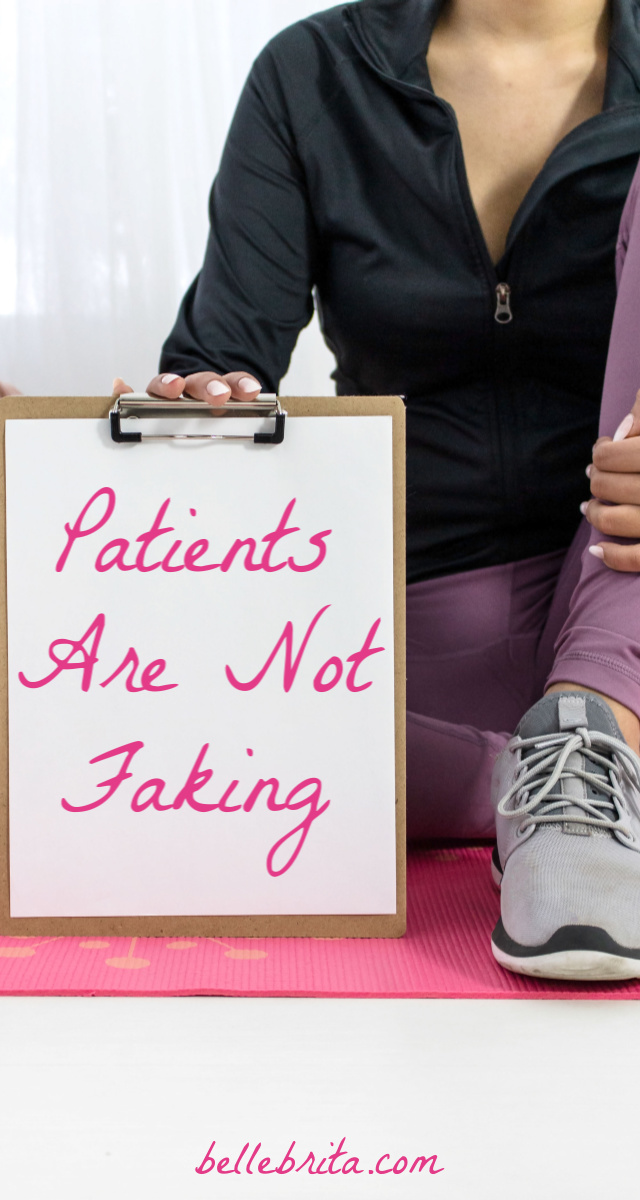When I was 8 years old, I was diagnosed with Crohn’s Disease.
How many times have I said this, or written this, or shared this misleadingly simple fact about my life?
And yet, while it’s an easy shorthand to explain my Crohn’s journey, my diagnosis wasn’t the beginning of my story. No, my story of life with a chronic illness began when I was 5 or 6.
My story began with inexplicable diarrhea.
Frequent fevers.
Complaints of tummy pain.
Little to no appetite.
Thinning hair.
Unexplained weight loss.
I only have a few snapshots in my mind of being so sick.
I was only 6 years old the first time I had to swallow pills, plastic capsules maybe 1/2 an inch in length.
At 7, during my family’s cross-country move from California to South Carolina, my mom gave me a pad to wear in my underwear in case I had a diarrhea accident.
The fever so high at the pediatrician’s office that the doctor immediately gave me medicine. And then back in the car, while still in the parking lot, I threw up all over myself.
Trying to sneak Pringles in the kitchen. My mom heard me, and scolded me at first, thinking the noise was my twin brother. When she saw it was me, she said it was okay to eat chips before dinner.
At the grocery store with my mom, enticed by a sale on Twix candy bars. Mom bought me two and let me eat them all by myself.
Crying myself to sleep because I thought I was dying.
These are the only things I remember about being sick in the years leading up to my diagnosis. Even then, when I was so sick and getting sicker, my parents still tried to let me live a normal life. I remember more about play dates and family trips than I do about being sick.
But I was sick, to the befuddlement of multiple pediatricians.
Finally, my mom, not knowing what else to do, started writing everything down. For about two weeks, she recorded every incident of diarrhea, every fever, every time I complained about my tummy–everything.
And then she took me back to the pediatrician with her records of my near-constant symptoms. Finally, my pediatrician recognized a pattern. He told my mom that I needed to see a pediatric gastroenterologist, either in Greenville, SC or in Augusta, GA.
I remember this office visit, this conversation. “If it was your daughter, where would you go?”
And so I was off to the Medical College of Georgia. After multiple visits and multiple tests, I finally had a diagnosis.
Crohn’s Disease.
In many ways, I was lucky. My family was lucky. My doctors all believed that I was sick. It just took time, and different medications, and eventually a litany of tests to find out why I was sick.
But my doctors believed me. They believed my pain.
And since then, all doctors have believed me. Having a childhood diagnosis of Crohn’s Disease certainly sucks in a lot of ways, but in my experience, it’s a surefire way for doctors to take my pain seriously, immediately.

In January 2010, I went to an Urgent Care with sharp pains on the right side of my abdomen. It didn’t take very long for the doctor to prescribe me morphine for the pain while we waited for my breakfast to digest sufficiently to do a CT scan of my abdomen. And not once in the Urgent Care, nor in the hospital where I transferred, did a single medical professional question me or doubt me whenever I asked for more morphine.
At some point in 2016 or 2017, I had sharp pains in different areas of my abdomen and pelvis. They would last anywhere from 1 minute to 10 minutes. My gastroenterologist squeezed me into his schedule with a next-day appointment, still spent 20 minutes talking to me and feeling my abdomen, and prescribed me two medications. One to fix the problem he thought I was experiencing, and Tramadol for the pain. (And yes, the first one did fix it, and I’ve miraculously not had this problem since then).
Unfortunately, not all patients receive such immediate and compassionate care as I do.
Patients Are Not Faking
A viral TikTok video shows a patient gasping for breath and a medical professional dancing. The creator shared this to Twitter with the words, “We know when y’all are faking.”
Twitter responded fiercely, tweeting with the hashtag #PatientsAreNotFaking.
U.S. blogger and disability rights advocate Imani Barbarin started the hashtag.
Tweets from Imani Barbarin #PatientsAreNotFaking
That video of the nurse dancing not believing patients has stirred up a lot of trauma for many in the disabled community and BIPOC communities.
People get killed because of that mentality. You did a whole video to tell us you’re bad at your job.#PatientsAreNotFaking
— @ImaniBarbarin@disabled.social (@Imani_Barbarin) November 22, 2019
My mom used to tell me to scream at the doctors if I was experiencing pain because if I acted like I was at a 10 at the pain scale, they would finally pay attention to my symptoms at 5. #PatientsAreNotFaking
— @ImaniBarbarin@disabled.social (@Imani_Barbarin) November 22, 2019
BIPOC are disproportionately represented in the number of preventable deaths specifically because they aren’t believed.
It’s more than a video of a nurse telling a joke, it’s about who is valued enough to be believed.#PatientsAreNotFaking
— @ImaniBarbarin@disabled.social (@Imani_Barbarin) November 22, 2019
My origin story is literally doctors not believing a young black mother that her child wasn’t moving the lower half of her body. #PatientsAreNotFaking
— @ImaniBarbarin@disabled.social (@Imani_Barbarin) November 22, 2019
Not only is #PatientsAreNotFaking a healthcare access issue, it is also a financial one because many people will try out multiple doctors until they’re believed.
That costs money.
— @ImaniBarbarin@disabled.social (@Imani_Barbarin) November 22, 2019
I’ve had doctors not even address me when talking about my own body. #PatientsAreNotFaking
— @ImaniBarbarin@disabled.social (@Imani_Barbarin) November 22, 2019
#PatientsAreNotFaking Tweets
People with disabilities and with chronic illnesses shared story after story of medical professionals not believing their pain, not ordering necessary tests, not prescribing medicine. Some patients have permanent damage due to this medical incompetence.
#PatientsAreNotFaking my surgeon tried to tell me that i didnt need a colonoscopy bc 'young girls just hold all their stress in their bellies.' after the procedure i was told my case of crohn's disease was so severe the camera couldnt pass thru my bowel & i could have died.
— sarah | free palestine 🇵🇸 (@garnoodles) November 22, 2019
https://twitter.com/FroBunni/status/1198012821994377216
I have endometriosis. When I have an ovarian or uterine cyst burst, I have basically just….stopped trying to seek any medical relief for the pain because I've been humiliated by enough ER nurses & doctors to know it's not worth it #PatientsAreNotFaking
— Elle Has Cats (and ADHD) (@ellle_em) November 23, 2019
https://twitter.com/SnoringDoggo/status/1198055795277148166
I was told multiple times over the course of several weeks in & out of the emergency room that I was having panic attacks & needed to calm down/relax.
Turns out, it’s extremely hard to relax when you’re having your first attack from Multiple Sclerosis (MS).#PatientsAreNotFaking
— Tori Saylor (@tori_saylor) November 23, 2019
People with disabilities and chronic illnesses aren’t the only patients suffering. Patients with kidney stones, appendicitis, strokes, heart attacks, and more have also all been dismissed by doctors, often with disastrous results.
I was not the "wrong age and wrong gender" for a heart attack, asshole. It kept going for 12 hours after hospital discharge, damaged my heart and ruined my life. Did your prejudicial dx ruin yours? I doubt it. #PatientsAreNotFaking
— Writing and Visual Art (@eatonhamilton) November 22, 2019
A female friend of mine went to the ER thinking she was having a heart attack. The doctor told her to learn the difference between heartburn and a heart attack and sent her home. The very next morning her husband found her dead in bed, from a heart attack! #PatientsAreNotFaking
— Jenny Noodle (@kuffymae) November 23, 2019
https://twitter.com/imshorty414/status/1198021218688876544
My mom was a bit overweight. Complained for months about gas and bloating. Was told to lose weight. Turned out she had an ovarian tumor the size of a pineapple #PatientsAreNotFaking
— Justine Barron (@jewstein3000) November 23, 2019
#PatientsAreNotFaking I passed out & woke up short of breath & with chest pain & rapid heart beat. The ER couldn't find anything immediately wrong, so sent me home. Turns out they sent me home w/o viewing my x-rays- got a call the next day that my LUNG PARTIALLY COLLAPSED.
— Alexis Collins (@Lexiscee) November 23, 2019
https://twitter.com/_GoneAway_/status/1197979058140786688
I was accused of being a drug seeker by one doc and later an alcoholic by another & was told I had given myself pancreatitis. Turns out it was pancreatic neuroendocrine cancer. That had metastasized and is now incurable. Because no one listened. #PatientsAreNotFaking
— Erin Leibowitz (@ErinLeibowitz) November 22, 2019
Bias in Healthcare
Bias in healthcare is a major issue, one that leads to patients dying from preventable and treatable medical conditions. Women are disproportionately treated poorly by medical professionals. This is even more true for women of color, for queer women, and for fat women. May God help you if you’re a fat, queer, woman of color.
Even wealth and fame aren’t always enough to overcome bias. After giving birth, Serena Williams had to push for the necessary tests and medical care she needed. In an interview with Vogue, Williams describes this ordeal:
The next day, while recovering in the hospital, Serena suddenly felt short of breath. Because of her history of blood clots, and because she was off her daily anticoagulant regimen due to the recent surgery, she immediately assumed she was having another pulmonary embolism. (Serena lives in fear of blood clots.) She walked out of the hospital room so her mother wouldn’t worry and told the nearest nurse, between gasps, that she needed a CT scan with contrast and IV heparin (a blood thinner) right away. The nurse thought her pain medicine might be making her confused. But Serena insisted, and soon enough a doctor was performing an ultrasound of her legs. “I was like, a Doppler? I told you, I need a CT scan and a heparin drip,” she remembers telling the team. The ultrasound revealed nothing, so they sent her for the CT, and sure enough, several small blood clots had settled in her lungs. Minutes later she was on the drip. “I was like, listen to Dr. Williams!”
Gender Bias in Healthcare
A 2018 paper looked at over 500,000 heart attack patient cases in Florida hospitals from 1991 to 2010. The researchers found that “female patients treated by male physicians were less likely to survive compared to all patients treated by female physicians or male patients treated by male doctors… the gender disparity in survival rate was triple for women who saw a male doctor compared with those who saw a female doctor.”
Unfortunately, that’s just the very beginning of gender bias in healthcare. An editorial titled Because Women’s Lives Matter, We Need to Eliminate Gender Bias summarizes dozens of studies on gender bias in healthcare. Here are just a few of the staggering differences.
- Women had pain for years longer than men before receiving referrals to pain clinics.
- Male trauma patients are more likely to be admitted to a trauma center, and they’re more likely to receive opioids for severe pain.
- For stroke patients, women receive less quality care than men in all areas. Women experience delays in provision of care, and they are less likely to receive recommended treatments and medications.
These are just a few of the problems regarding gender bias in healthcare.

Women also face gender gaps in medical research. In an op-ed for The Washington Post, Caroline Criado Perez writes:
Contrary to all evidence, you will still find plenty of researchers insisting that including female patients in clinical trials is a waste of time and money because their bodies are just too complicated, too variable, too hormonal to be a good research vessel.
The problem, to state the obvious, is that those complicated bodies are going to be taking the drugs anyway, so it would be good to have some data on how they interact, especially since the data we do have is so troubling. Menstrual-cycle impacts have so far been found for antipsychotics, antidepressants, antihistamines and antibiotic treatments as well as heart medication.
Perez’s book Invisible Women dives into the data bias that inadvertently harms so many women, both in our daily lives and in healthcare settings.
And while this blog post is primarily about the negative experiences of patients, I must add that women who work in the healthcare industry also face obstacles due to sexism.
Racial Bias in Healthcare
Unfortunately, racism is also a problem in the healthcare field. Multiple studies indicate that black Americans receive substandard care in comparison to their white counterparts. This is even after adjust for other factors such as income and access to health insurance. Some of these differences include:
- Black patients were less likely to receive coronary bypass operations and angiography.
- Black women are less likely than white women to receive radiation therapy in conjunction with a mastectomy.
- The rates at which black patients have their limbs amputated is higher than those for white patients.
One horrifying difference in healthcare is the pregnancy-related mortality rates of women. From 2011 to 2014, the pregnancy-related mortality ratios were as follows:
- 40.0 deaths per 100,000 black women
- 17.8 deaths per 100,000 women of other minority races
- 12.4 deaths per 100,000 white women
NPR puts this disparity into perspective.
A black woman is 22 percent more likely to die from heart disease than a white woman, 71 percent more likely to perish from cervical cancer, but 243 percent more likely to die from pregnancy- or childbirth-related causes.
Additional reading on racial bias in healthcare:
- Doctors and Racial Bias: Still a Long Way to Go
- Millions of black people affected by racial bias in health-care algorithms

Other Biases in Healthcare
A single blog post cannot exhaustively explore every form of bias in healthcare. However, I do want to mention briefly two other areas of discrimination in healthcare. Both LGBTQ+ patients and fat patients receive inadequate medical care due to bias. The following articles shed light on these problems:
- Discrimination Prevents LGBTQ People From Accessing Health Care
- 10 Stats You Need to Know About LGBT Healthcare
- Addressing weight bias in medicine
- The Shocking Ways Large Women Are Mistreated by Health-Care Providers
How to Address Bias in Healthcare
Unfortunately, much of bias in healthcare is implicit (meaning medical professionals don’t realize they’re biased) and/or systemic (meaning the bias is built into healthcare systems themselves). Challenging bias in healthcare will take a great deal more effort than reading a blog post or sharing a tweet. However, incremental change still makes a difference.
If you are a patient:
- If you can, take someone with you who will advocate for your healthcare.
- If possible, get a second opinion.
- Document, document, document. Keep a written journal of your symptoms, your medical appointments, your interactions with doctors, EVERYTHING. Get copies of your medical tests and keep them in your journal.
- Do your own research. Know the possible diagnoses for your symptoms. Know the possible treatments for your condition. Bring them up with your doctor.
- Be polite, but be firm, and be assertive. It’s okay to argue with a medical professional. It’s okay to insist on tests or treatments. Be persistent until you’re taken seriously.
If you are a friend or relative:
- Believe your loved one. They are not faking their symptoms. They are not exaggerating their bad experiences getting healthcare.
- Advocate for your loved one. Accompany them to the doctor. Speak up and corroborate their symptoms. Take notes during the appointment. Ask questions.
If you are a healthcare provider:
- Believe your patients. All of them. Even the minority of patients who are seeking drugs still deserve compassion and care.
- Actively listen to your patients.
- Don’t make assumptions about your patient.
- Actually look at test results before giving a diagnosis.
- Discuss all treatment options with your patient, offering the pros and cons of each treatment.
- Be willing to consult with another medical professional if you’re not sure.
If you found this blog post helpful or enlightening, please share it on social media.
Now I want to hear from you. What are your experiences as a patient navigating the healthcare industry?
